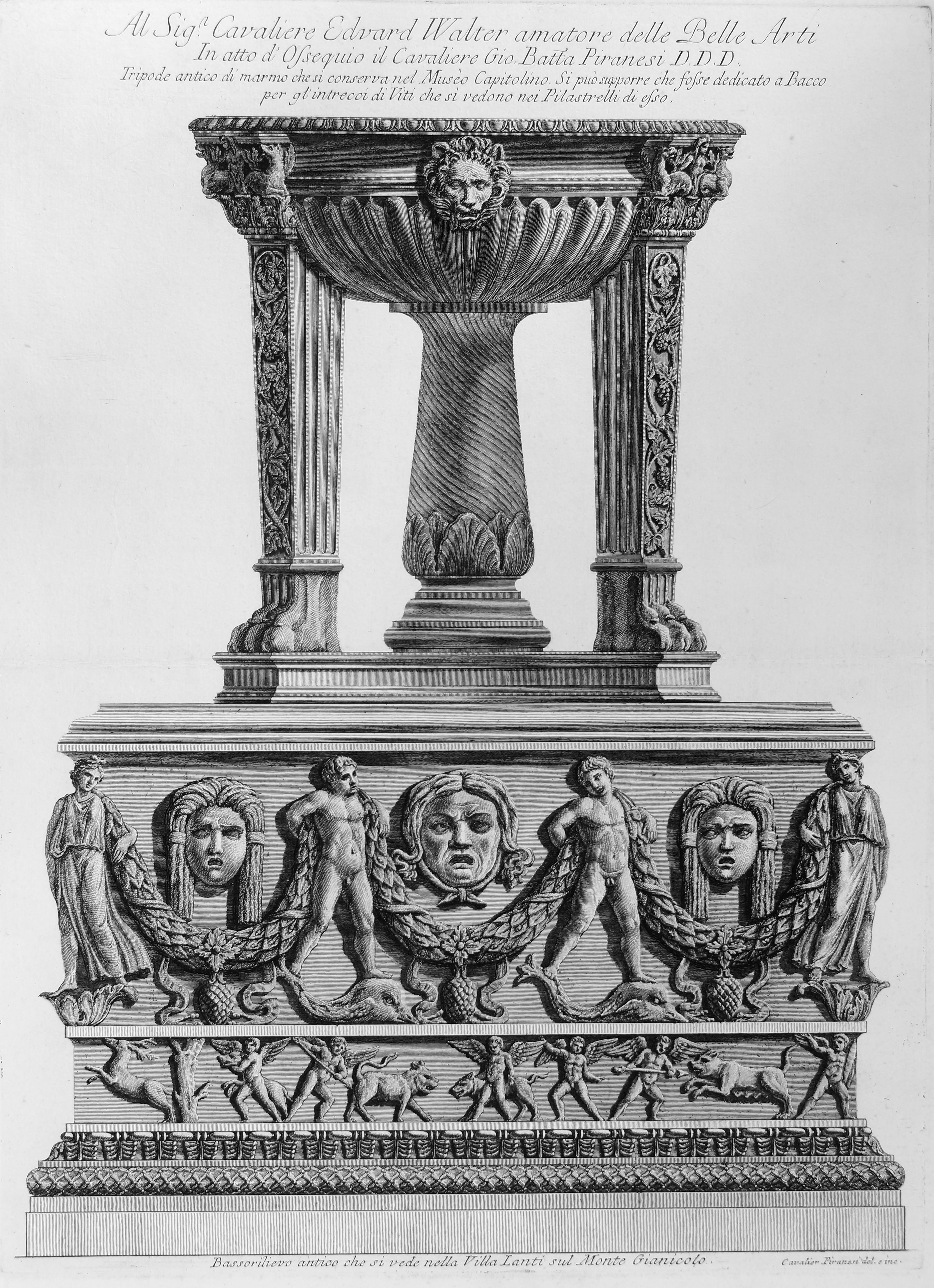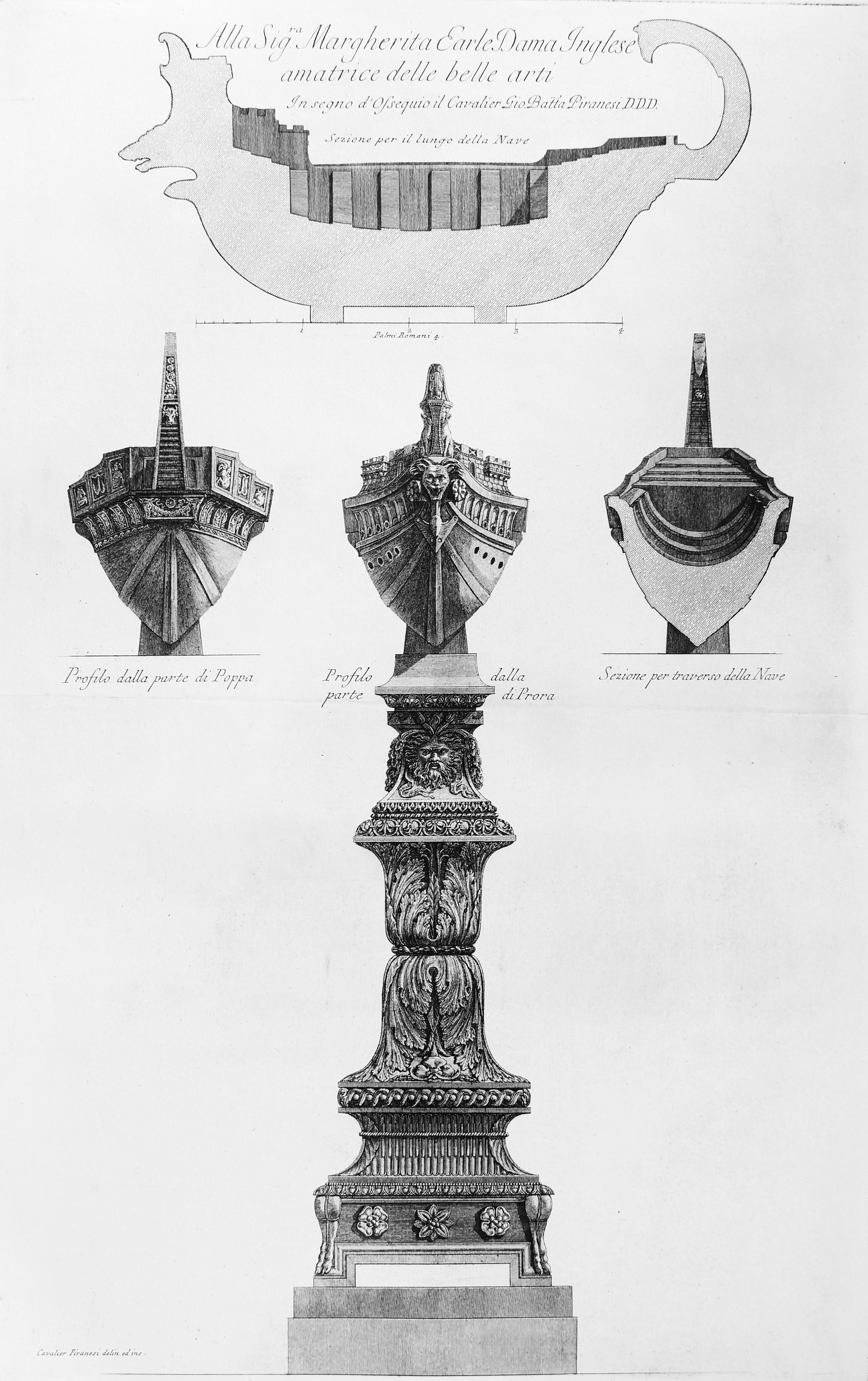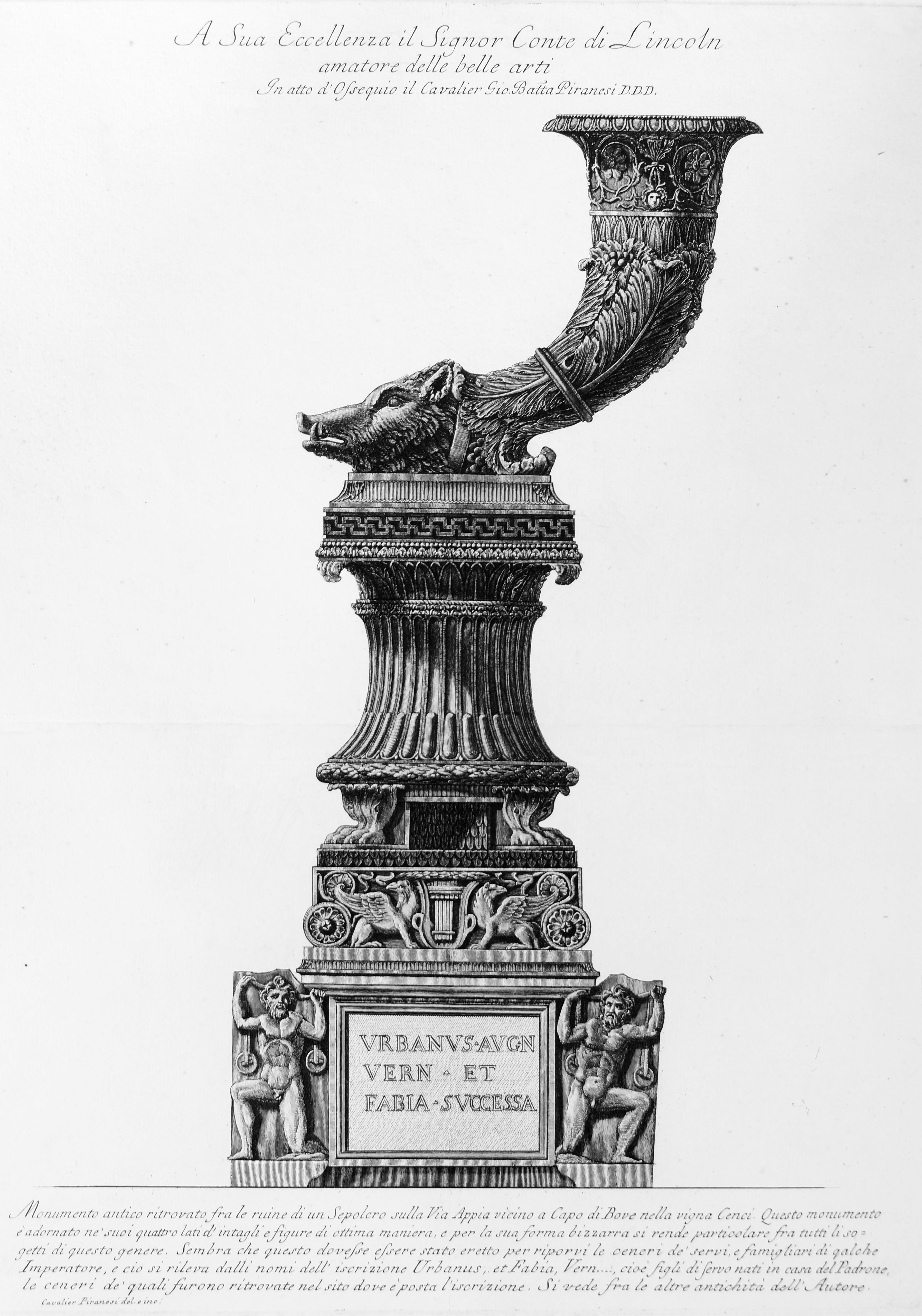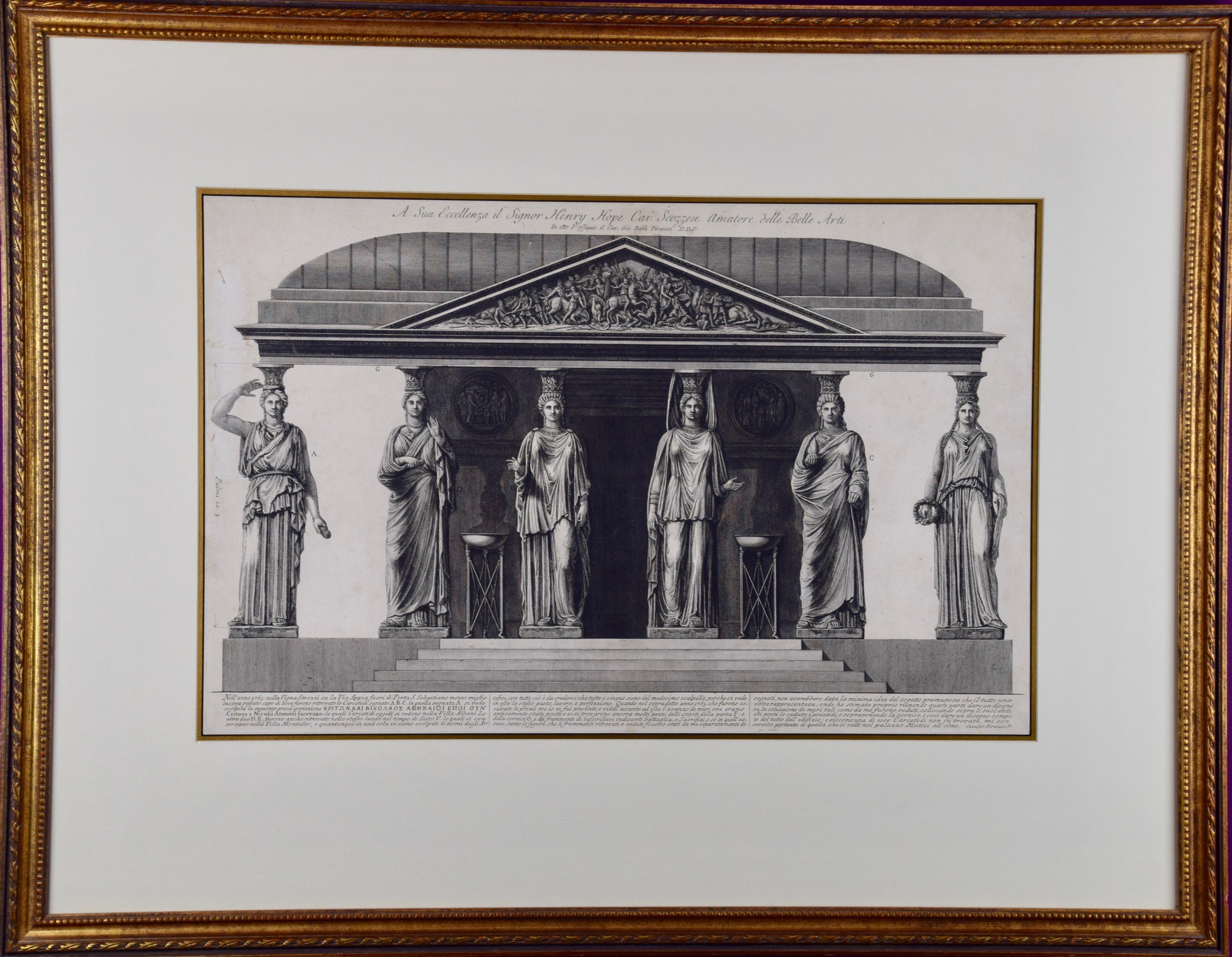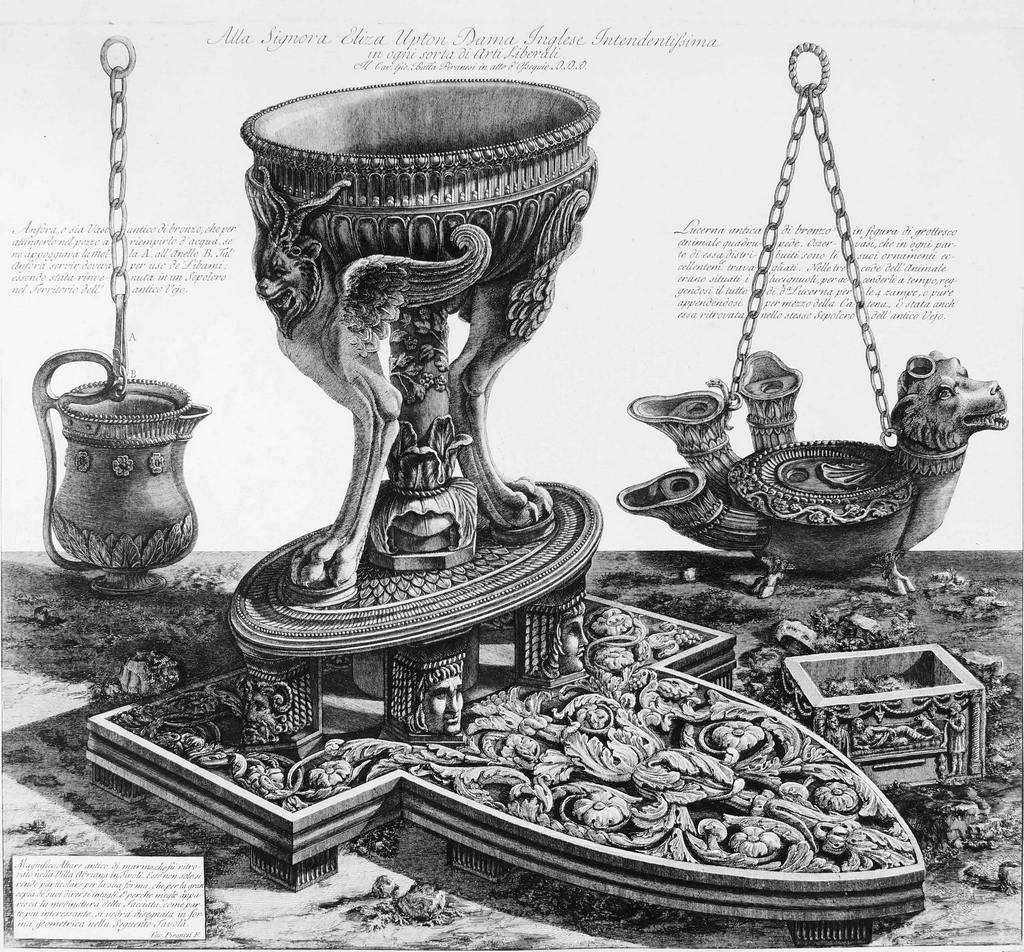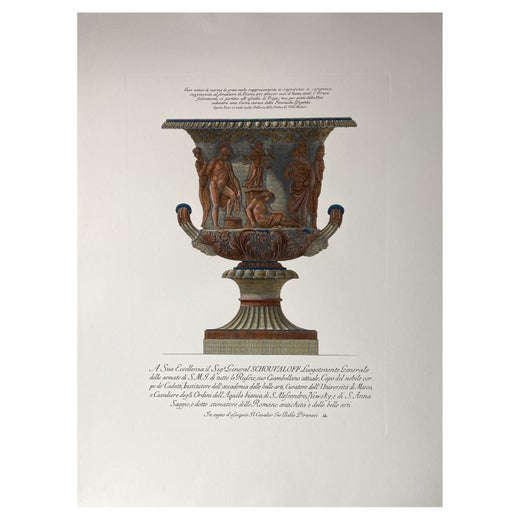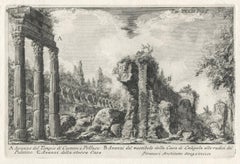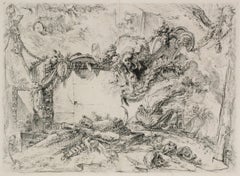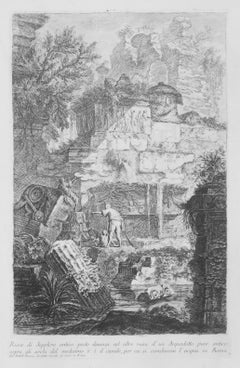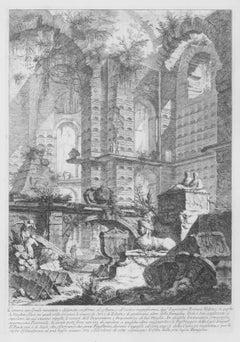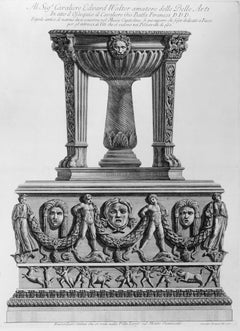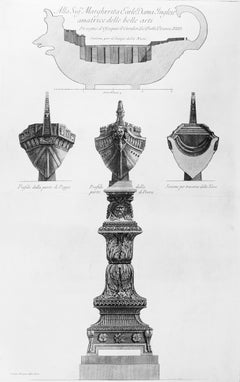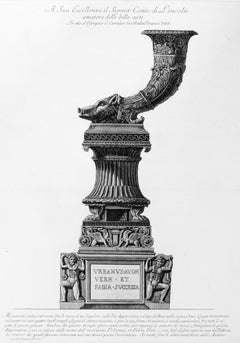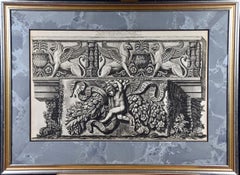Items Similar to Marble relief of a trireme from the Temple of Fortuna, Praeneste, from Vasi
Want more images or videos?
Request additional images or videos from the seller
1 of 11
Giovanni Battista PiranesiMarble relief of a trireme from the Temple of Fortuna, Praeneste, from Vasi1778-1780
1778-1780
$1,500
£1,132.74
€1,296.88
CA$2,118.39
A$2,312.78
CHF 1,212.49
MX$28,089.57
NOK 15,142.08
SEK 14,298.16
DKK 9,679.85
About the Item
Marble relief of a trireme from the Temple of Fortuna, Praeneste, from Vasi, candelabri, cippi, sarcofagi, tripodi, lucerne, ed ornamenti antichi disegnati ed incisi dal Cav. Gio. Batt. Piranesi, Vol. II (Vases, candelabra, grave stones, sarcophagi, tripods, lamps, and ornaments designed and etched by Cavalieri Giovanni Battista Piranesi)
Etching, 1778-1780
Signed lower right: Cavalier Piranesi F.
Marble relief of a trireme from the Temple of Fortuna, Praeneste,
From Vasi, candelabri, cippi, sarcofagi, tripodi, lucerne, ed ornamenti antichi disegnati ed incisi dal Cav. Gio. Batt. Piranesi, Vol. II (Vases, candelabra, grave stones, sarcophagi, tripods, lamps, and ornaments designed and etched by Cavalieri Giovanni Battista Piranesi)
An impression is in the collection of the Metropolitan Museum of Art
A Roman printing on Double Circle Fleur de Lys paper
Condition: Original condition with small stains and waviness to the paper
Image/Plate size: 14 15/16 x 20 1/2 inches
Sheet size: 23 1/8 x 33 3/4 inches
Reference: Wilton-Ely 904
Focillon 617
Inscription: At bottom center: Parte angolare di Antico Fregio di Marmo, antica camerite appareneva alla fabrica aggiunta al Tempio della Fotuna in Preneste e fatta fare da Augusto dopo a vittoria ottenuta ad Azzio. Si vedeva una volta nella villa dell'Eccmo. Sig.r (r as superscript) Prinpe Barberini in Palestrina oggidì nel nuovo Musèo / Clementino in Vaticano. Allorchè intiero si vedeva tutto il fregio della detta favrica rappresentava le principali Navi Turrit.e (e as superscript) e soggiogate nella guerra sudetta contro Marc'Antonio, e Cleopatra. A. Coccodrillo Insegno di Nave Alessandrina, che si appoggiaa sopar i lavori di metallo appartenenti di Rostro B. / cioè divisa di prora, e non di popppa da altri malamente creduta. C Antenna della nave. D Acrostilio. E Ritratto a grottesco creduto di Marc'Antonio con la corazza, e squamme. F Parte de due ordini di remi. G Saccoccie di pelli formate non chiodi. H entro le quali sono legati i manubrj de remi, accicò non entri l'acqua nella nave. I / Catastromo, o tavoluto, che copriva la ciurma de marinarj, che remigavono coi manubrj, e perciò si dicevano navi costrate, sopra di questo catastrommo combattevasi contro i nemici. L Podio onrato di scudi a guisa d'antimurale per difesa de combattenti, cioè di quelli della parte opposta della nave, ed anche per quelli / che agivano nel mezzo di essa. M Soggetti Primarj, che potrebbe supprfi essere Augusto ed Agrippa, collocati sul catastromo, N Officiali, e Soldati armati di corazza, con grandi scudi ed aste, O Centurione o Navarco appoggiato all'edicola, ove si vede l'immagine di Cleopatra col diadema questa edicola e'an- / nessa alla nave, e non portatile Notasi, che fuori di questa, e quelle di Marc'Antonio, tutte l'altro Teste sono Modern.e (e as superscript). P Torre di legno sopra di cui si combatteva, e che per mezzo di essa da a conoscere essere stata la nave molto grande, Q Avanzo di rostro dell'altra nave, che proseguiva nel seguito del fregio. R Carina, o / sia testuggine della nave. S Membri d'architettura appartenenenti al fregio, e soliti a farsi per racchiudere le figure del bassorilievo. T Cavallo nella voltata del fregio forse uno di quelli del seguito d'Augusto quando si porto'al Tempio della Fortuna sudetta.
- Creator:Giovanni Battista Piranesi (1720-1778, Italian)
- Creation Year:1778-1780
- Dimensions:Height: 14.93 in (37.93 cm)Width: 20.5 in (52.07 cm)
- Medium:
- Movement & Style:
- Period:1770-1779
- Condition:
- Gallery Location:Fairlawn, OH
- Reference Number:Seller: FA123851stDibs: LU14015913752
Giovanni Battista Piranesi
Piranesi was born in Venice in 1720 and died in Rome in 1778. He was the son of a stone mason and was trained as an architect. After a slow start he eventually achieved great success as an architect, archaeologist, artist, designer, collector, and antiquities dealer. His mission was to glorify the architecture of ancient Rome through his engravings and etchings. His highly dramatized prints often depict imaginary interiors and frequently include figures in mysterious activities, who are dwarfed by the magnitude of their monumental surroundings. Piranesi's style greatly influenced the neoclassical art movement of the late 18th century. His dramatic scenes inspired generations of set designers, as well as artists, architects and writers. His prints have continued to increase in value to institutions and collectors.
About the Seller
5.0
Recognized Seller
These prestigious sellers are industry leaders and represent the highest echelon for item quality and design.
Platinum Seller
Premium sellers with a 4.7+ rating and 24-hour response times
Established in 1978
1stDibs seller since 2013
814 sales on 1stDibs
Typical response time: <1 hour
Associations
International Fine Print Dealers Association
- ShippingRetrieving quote...Shipping from: Akron, OH
- Return Policy
Authenticity Guarantee
In the unlikely event there’s an issue with an item’s authenticity, contact us within 1 year for a full refund. DetailsMoney-Back Guarantee
If your item is not as described, is damaged in transit, or does not arrive, contact us within 7 days for a full refund. Details24-Hour Cancellation
You have a 24-hour grace period in which to reconsider your purchase, with no questions asked.Vetted Professional Sellers
Our world-class sellers must adhere to strict standards for service and quality, maintaining the integrity of our listings.Price-Match Guarantee
If you find that a seller listed the same item for a lower price elsewhere, we’ll match it.Trusted Global Delivery
Our best-in-class carrier network provides specialized shipping options worldwide, including custom delivery.More From This Seller
View AllXXXIII Fig. I Avanzo del Tempio di Castore e Polluce
By Giovanni Battista Piranesi
Located in Fairlawn, OH
XXXIII Fig. I Avanzo del Tempio di Castore e Polluce .View of the Remains of the Peristyle of the House of Nero,
Etching, 1756
Signed in the plate (see photo)
From: Le Antichità Roma...
Category
1750s Old Masters Landscape Prints
Materials
Etching
The Monumental Tablet
By Giovanni Battista Piranesi
Located in Fairlawn, OH
The Monumental Tablet
Etching, engraving, drypoint and burnishing, c. 1748
Series: Grotteschi (Grotesques, 4 plates)
Original, unwashed condition. Excellent.
Second edition first is...
Category
1740s Old Masters Prints and Multiples
Materials
Etching
Ruine di Sepolcro antico
By Giovanni Battista Piranesi
Located in Fairlawn, OH
Ruine di Sepolcro antico
Etching, 1743
Signed in the plate bottomleft in the caaption plate
From: Prima Parte, 1743
Second edition: 1750-1778
Watermark: R 37-39
A lifetime impression printed during Piranesi’s life, before the plates are moved to Paris by his sons in the 1790’s
Coniditon: Excellent/Very good
Image size: 14 5/8 x 9 3/4 inches
Reference: Robison 17 iii/V
Piranesi In Rome: Prima Parte di Architetture e Prospettive
"Although Piranesi studied architecture in Venice, he never was able to find work in the field other than a few jobs involving remodeling in Rome. While Piranesi was struggling to support his architectural endeavors upon his arrival in Rome in 1740, he spent a short period of time in the studio of master painter Giovanni Battista Tiepolo (1696-1770) in addition to his apprenticeship with Giuseppe Vasi. The first production of Piranesi’s early years in Rome and a culmination of his training under Vasi, Tiepolo, and his uncle, was the Prima Parte di Architetture e Prospettive (1743). The Prima Parte was a collection of twelve etchings of imaginary temples, palaces, ruins, and a prison. During this time, Piranesi was still developing the unique style of etching he is known for today, and as such the Prima Parte differs significantly in technique compared to later works. In the Frontispiece of the Prima Parte, Piranesi’s lines are definite and exact with very little flow to them, designed in the form of traditional etching. The detail is immaculate, and yet perspective of the piece is oddly simple and familiar to the viewer. Piranesi’s technique employs miniscule markings and lines, intricately woven together to create a stippling effect. The Prima Parte, described as “rigid” by art historian Jonathan Scott, came to be seen as a stark contrast to his later sketches, which were much lighter and freer. Influenced by the style of Tiepolo, which epitomized the lightness and brightness of the Rococo period, Piranesi adopted some of the more painterly techniques of the masters he apprenticed under. Piranesi made the medium of etching appear as though it was a sketch or a painting, hence a “freer” and more fluid design in his later works. For example, the frontispiece of the Prima Parte read as an etching to Piranesi’s audience, but in his later vedute, the style of etching almost appears to be made of brushstrokes. Moreover, at the same time Piranesi was working on the Prima Parte, he aided the artist Giambattista Nolli. There is a small section of Nolli’s map...
Category
1740s Old Masters Interior Prints
Materials
Etching
Camera sepolcrale
By Giovanni Battista Piranesi
Located in Fairlawn, OH
Camera sepolcrale
Etching 1743
Signed in the bottom left corner
From: Prima Parte, 1743
Second edition: 1750-1778
Watermark: R 37-39
A lifetime impression printed during Piranesi’s life, before the plates are moved to Paris by his sons in the 1790’s
Condition: Excellent
Image size: 14 5/8 x 9 3/4 inches
Reference: Robison 20 iii/V
Piranesi In Rome: Prima Parte di Architetture e Prospettive
"Although Piranesi studied architecture in Venice, he never was able to find work in the field other than a few jobs involving remodeling in Rome. While Piranesi was struggling to support his architectural endeavors upon his arrival in Rome in 1740, he spent a short period of time in the studio of master painter Giovanni Battista Tiepolo (1696-1770) in addition to his apprenticeship with Giuseppe Vasi. The first production of Piranesi’s early years in Rome and a culmination of his training under Vasi, Tiepolo, and his uncle, was the Prima Parte di Architetture e Prospettive (1743). The Prima Parte was a collection of twelve etchings of imaginary temples, palaces, ruins, and a prison. During this time, Piranesi was still developing the unique style of etching he is known for today, and as such the Prima Parte differs significantly in technique compared to later works. In the Frontispiece of the Prima Parte, Piranesi’s lines are definite and exact with very little flow to them, designed in the form of traditional etching. The detail is immaculate, and yet perspective of the piece is oddly simple and familiar to the viewer. Piranesi’s technique employs miniscule markings and lines, intricately woven together to create a stippling effect. The Prima Parte, described as “rigid” by art historian Jonathan Scott, came to be seen as a stark contrast to his later sketches, which were much lighter and freer. Influenced by the style of Tiepolo, which epitomized the lightness and brightness of the Rococo period, Piranesi adopted some of the more painterly techniques of the masters he apprenticed under. Piranesi made the medium of etching appear as though it was a sketch or a painting, hence a “freer” and more fluid design in his later works. For example, the frontispiece of the Prima Parte read as an etching to Piranesi’s audience, but in his later vedute, the style of etching almost appears to be made of brushstrokes. Moreover, at the same time Piranesi was working on the Prima Parte, he aided the artist Giambattista Nolli. There is a small section of Nolli’s map...
Category
1740s Old Masters Interior Prints
Materials
Etching
View of the Ancient Structure built by Tarquinius Superbus called the Bel Lido
By Giovanni Battista Piranesi
Located in Fairlawn, OH
View of the Ancient Structure built by Tarquinius Superbus called the Bel Lido, and like others built by Marcus Agrippa in the time of Augustus when he cleaned all the sewers leading...
Category
1750s Old Masters Landscape Prints
Materials
Etching
Galleria grande di Statue
By Giovanni Battista Piranesi
Located in Fairlawn, OH
Galleria grande di Statue
Etching, 1743
Signed lower left corner of the plate
From: Prima Parte, 1743
Second edition: 1750-1778
Watermark: R 37-39
A lifetime impression printed during Piranesi’s life, before the plates are moved to Paris by his sons in the 1790’s
Condition: Excellent
Image size: 14 5/8 x 9 3/4 inches
Reference: Robison 2 iii/V
Piranesi In Rome: Prima Parte di Architetture e Prospettive
"Although Piranesi studied architecture in Venice, he never was able to find work in the field other than a few jobs involving remodeling in Rome. While Piranesi was struggling to support his architectural endeavors upon his arrival in Rome in 1740, he spent a short period of time in the studio of master painter Giovanni Battista Tiepolo (1696-1770) in addition to his apprenticeship with Giuseppe Vasi. The first production of Piranesi’s early years in Rome and a culmination of his training under Vasi, Tiepolo, and his uncle, was the Prima Parte di Architetture e Prospettive (1743). The Prima Parte was a collection of twelve etchings of imaginary temples, palaces, ruins, and a prison. During this time, Piranesi was still developing the unique style of etching he is known for today, and as such the Prima Parte differs significantly in technique compared to later works. In the Frontispiece of the Prima Parte, Piranesi’s lines are definite and exact with very little flow to them, designed in the form of traditional etching. The detail is immaculate, and yet perspective of the piece is oddly simple and familiar to the viewer. Piranesi’s technique employs miniscule markings and lines, intricately woven together to create a stippling effect. The Prima Parte, described as “rigid” by art historian Jonathan Scott, came to be seen as a stark contrast to his later sketches, which were much lighter and freer. Influenced by the style of Tiepolo, which epitomized the lightness and brightness of the Rococo period, Piranesi adopted some of the more painterly techniques of the masters he apprenticed under. Piranesi made the medium of etching appear as though it was a sketch or a painting, hence a “freer” and more fluid design in his later works. For example, the frontispiece of the Prima Parte read as an etching to Piranesi’s audience, but in his later vedute, the style of etching almost appears to be made of brushstrokes. Moreover, at the same time Piranesi was working on the Prima Parte, he aided the artist Giambattista Nolli. There is a small section of Nolli’s map...
Category
1740s Old Masters Landscape Prints
Materials
Etching
You May Also Like
Tripode antico di marmo che si conserva nel Museo Capitolino - Etching 1778
By Giovanni Battista Piranesi
Located in Roma, IT
English Title: Ancient Tripod Store in the Capitoline Museums...
Artist proof, printed on contemporary laid paper, wide margins, representing a “tripod from Villa lanti, Gianicolo (Rome)”. Etching with strong contrasts and sharp details. with a dedication to “Cavaliere Edward Walter”. Signed on plate "Cavalier Piranesi del. e inc.". Good condition, lightly worn paper, normal folds and little holes on higher margin due to the binding of the volume “Vases and Candelabras...
Category
Late 18th Century Figurative Prints
Materials
Etching
Sezione per il Luogo della Nave - Etching by G.B. Piranesi - 1778
By Giovanni Battista Piranesi
Located in Roma, IT
Section for the place of the boat.
Wonderful proof, printed on contemporary laid paper, wide margins, representing a “section for the place of the boat”. Etching with good contrasts ...
Category
Late 18th Century Figurative Prints
Materials
Etching
Monumento antico ritrovato fra le rovine di un Sepolcro sulla Via Appia - 1778
By Giovanni Battista Piranesi
Located in Roma, IT
Antique monument found in a tomb on the Via Appia
Artist proof, printed on contemporary laid paper, wide margins, representing an “antique monument found in ...
Category
Late 18th Century Figurative Prints
Materials
Etching
Ancient Roman Architectural Frieze: An 18th C. Piranesi Etching
By Giovanni Battista Piranesi
Located in Alamo, CA
This framed original 18th century etching is entitled "Fregio antico di marmo con Ippogrifi, nel cortile del palazzo della Valle" (Ancient Marble Frieze with Hippogriffs in the Courtyard of The Palace of the Valley). The etching is by Giovanni Battista Piranesi, published in Rome in 1778. It is from Piranesi's monumental work "Vasi, Candelabri, Cippi, Sarcofagi, Tripodi, Lucerne, Ed Ornamenti Antichi", (Vases, candelabra, grave stones...
Category
Early 18th Century Old Masters Figurative Prints
Materials
Etching
Ancient Roman Architecture: Framed Original 18th C. Etching by G. Piranesi
By Giovanni Battista Piranesi
Located in Alamo, CA
"A sua Eccellenza il Signor Henry Hope Cav. Scozzese Amatore delle Belle Arti from "Vasi, Candelabri, Cippi, Sarcofagi, Tripodi, Lucerne, Ed Ornamenti Antichi", (Vases, candelabra, grave stones, sarcophagi, tripods, lamps, and ancient ornaments) is an etching by Giovanni Battista Piranesi, published in 1778. It depicts stone caryatids...
Category
1770s Old Masters Figurative Prints
Materials
Etching
Altra veduta del medesimo in prospettiva...
By Giovanni Battista Piranesi
Located in Roma, IT
Title : Altra veduta del medesimo in prospettiva, fra una lampada e un piccolo vaso in bronzo
Artist proof, with a good contrast and sharp details, printed on antique laid paper, lar...
Category
1770s Old Masters Figurative Prints
Materials
Drypoint
More Ways To Browse
Marble Relief
Antique Marble Relief
Antique Tripod Lamp
Skate Decks Keith Haring
Sophy Brown
Southwest Vintage Posters
Sticky Fingers Album
Sunset Peter Max
Tammy Wynette
Tarkay Lithograph
Tessa Beaver
The Physiognomy Ear
Van Strydonck
Venus In Furs
Vintage Continental Airlines Poster
Vintage Lunch Counter
Warhol Alexander
Warhol Batman
